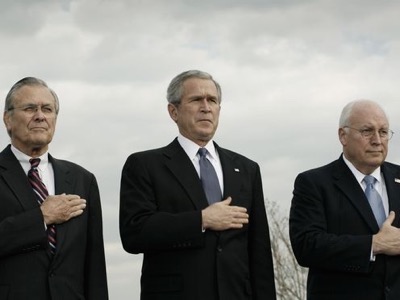Será
que não conseguem perceber a guerra a surgir no horizonte?
Paul Craig Roberts
De
acordo com notícias da imprensa britânica, o Presidente russo, Vladimir Putin,
deu ordem às indústrias russas para se prepararem de modo a poderem mudar
rapidamente para uma produção de guerra.
Claro
que o governo russo não faria tal anúncio a não ser que estivesse convencido de
que a perspectiva da guerra com o Ocidente fosse real. Há já algum tempo, que
tenho salientado nas minhas colunas que, a consequência das acções hostis há
alguns anos, levadas a cabo por Washington e pelos seus vassalos europeus, contra a Rússia, conduziam à guerra.
É
fácil perceber que o enorme complexo militar/segurança dos EUA precisa de um
inimigo convincente para justificar o seu enorme orçamento, que os alucinados neoconservadores
colocam a ideologia fantasiosa de uma hegemonia mundial dos EUA acima da vida
do planeta, e que Hillary e a Comissão do Partido Democrata Nacional farão
qualquer coisa para derrubar a vitória presidencial de Trump. No entanto, é
difícil compreender por que motivo os líderes políticos europeus estão
dispostos a colocar os seus países em risco a fim de beneficiarem Washington.
No
entanto, fazem-no. Por exemplo, em 13 de Novembro, a Primeira Ministra do Reino Unido, Theresa
May, disse que a Rússia era uma ameaça à segurança internacional e que estava a
interferir nas eleições europeias e a piratear informaticamente os governos europeus.
Não há provas para essas reivindicações como não há para o “Russiagate”. No entanto,
as alegações continuam e multiplicam-se. Presentemente, a União Europeia está a coordenar as
antigas províncias da União Soviética - Bielorrússia, Moldávia,
Ucrânia, Geórgia, Arménia e Azerbaijão - numa "Parceria Oriental" com
essa mesma União Europeia. https://www.strategic-culture.org/news/2017/11/27/british-pm-makes-clear-eastern-partnership-created-damage-russia.html
Por
outras palavras, o Ocidente está a coordenar abertamente as antigas províncias
de Moscovo contra a Rússia, que é declarada pela Primeira Ministra, Teresa May
como sendo um "Estado hostil". A Rússia sabe que não há fundamentos
para essas alegações e considera-as idênticas às alegações falsas
contra Saddam Hussein, Gaddafi e Assad para justificar os ataques militares
contra o Iraque, Líbia e Síria. Tendo convencido a Rússia de que ela está a ser encarada como um alvo a atacar, a mesma está a preparar-se contra a guerra.
Pensem
nisto durante um momento. O mundo está a ser conduzido ao Armageddon,
simplesmente porque o complexo militar/segurança, corrupto e ganancioso, precisa
de um inimigo para justificar o seu enorme orçamento, porque Hillary e o DNC
não podem aceitar uma derrota política e porque os neoconservadores têm a
ideologia da Supremacia Americana.
Qual é a diferença entre a detestada Supremacia Branca e a Supremacia Americana que o próprio Presidente Obama aprovou? Por que motivo a supremacia branca é terrível e a Supremacia Americana é uma dádiva que Deus ofereceu a este país “excepcional” e “indispensável”?
Qual é a diferença entre a detestada Supremacia Branca e a Supremacia Americana que o próprio Presidente Obama aprovou? Por que motivo a supremacia branca é terrível e a Supremacia Americana é uma dádiva que Deus ofereceu a este país “excepcional” e “indispensável”?
O
governo russo partilhou abertamente a sua preocupação pelo facto da Rússia estar a ser considerada
um alvo para ataques militares. Tal como eu e mesmo a CNN, o New York Times e o
Washington Post, relataram, o Vice-Comandante do Comando de Operações Militares russas declarou publicamente a preocupação de que Washington esteja a
preparar um ataque nuclear surpresa contra a Rússia. O Presidente Putin chamou
a atenção, recentemente, para a recolha de DNA russo, a mando de Washington e
levada a cabo por um laboratório de armamento da Força Aérea dos EUA, o que
implica o desenvolvimento de uma arma biológica específica contra a Rússia. Em
muitas ocasiões, a Rússia chamou a atenção para as bases dos EUA e da NATO nas
suas fronteiras, apesar das garantias anteriores das administrações dos EUA de
que tal situação nunca iria acontecer.
Temos
de nos interrogar:
- Por que razão é que este assunto não é o principal ponto de
discussão pública e política – de que Washington convenceu a Rússia de que ela,
um poder nuclear e militar de primeiro grau, vai ser atacada?
Em vez disso,
ouvimos falar de jogadores de futebol que se ajoelham ao escutar o hino
nacional, notícias falsas sobre Russiagate, um tiroteio em Las Vegas, etc.
Também
devemos interrogar-nos:
- Durante quanto tempo Washington vai permitir que
qualquer um de nós, através da Internet, relate notícias verdadeiras em vez das
falsas que Washington divulga, para controlar as explicações?
O esforço do
presidente da Comissão Federal de Comunicações para destruir a neutralidade da
rede e outros esforços em curso para desacreditar as notícias verdadeiras, pois
que a propaganda russa indica que Washington concluiu que, para lançar a guerra
contra a Rússia, Washington também deve lançar a guerra contra a verdade.
Washington
não vai sobreviver à sua guerra, nem os povos americanos, nem os europeus.
[Ndt –
nem a espécie humana, animal e vegetal sobreviverá a um Inverno Nuclear].











